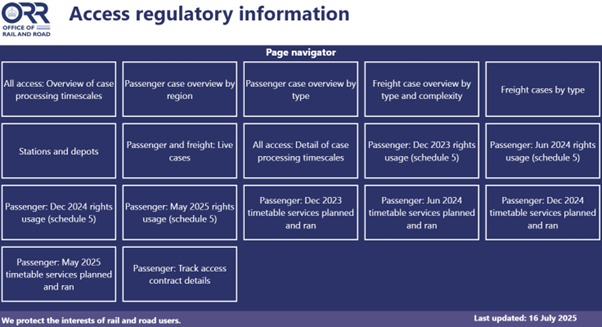This publication provides management information on access rights planning and use.
It provides management information on access rights planning and use. It provides a holistic view of passenger track access rights and can display how these are being used across the network including:
- track access applications made by freight and passenger operators of rail services in Great Britain;
- the submission and approval timescales for passenger track applications against the timetable production milestones of the Network Code; and
- information on the use of access rights by passenger operators.
The latest data includes applications up to the Subsidiary Timetable Change which began operation on 18 May 2025. Download the factsheet for more details.
The factsheet is accompanied by a Power BI dashboard and data tables available below.
View the glossary for more information on dashboard terminology.
View the dashboard, hosted on Power BI:
Key messages
- Passenger train operators made 28 applications for additional or different capacity use (track access) for the timetable change date on 18 May 2025 which enabled them to deliver improved or continued services. ORR assessed and approved these applications ahead of the timetable change to provide certainty to operators, passengers and freight customers.
- As with December 2024, many these applications for May 2025 were submitted close to the timetable change. 25 applications were submitted after the industry deadline for publishing the timetable and when advance ticket booking opens (‘D12’ – 12 weeks before the timetable change). This introduces a potential risk for operators (and passengers) of timetabled services not having the right to use the network. In part, this was because Network Rail was not able to offer long term access to all operators who had applied for it as part of the competing applications process in May 2024. Instead, it continued its interim approach of supporting short term access for May 2025 in the 9 interacting locations included in this letter.
- As of 13 July 2025, passenger operators planned to use 90 per cent of the total contracted rights (capacity) allocated in the period since the 18 May timetable change, and during the same period these operators actually ran train services which used 86 per cent of the total capacity allocated in terms of rights.
- There is a large amount of variability on an operator and service group level in terms of services planned and ran. For example, a number of operators were impacted on the West Coast Mainline due to overhead line failures. Other operators were impacted by planned or short notice engineering access as well as decisions by operators and funders on when services run impact the use of rights.
- Some operators are consistently low in terms of services planned and ran and we expect these operators to work with Network Rail to ensure their contracts accurately reflect the rights required.
- In some instances, operators did not explain differences between the rights held and the services planned or ran. It is important for industry to understand its rights in the timetable better to ensure capacity is used most effectively.
- The timetable monitoring production data published by ORR is a useful comparison for looking at when operators had access rights in place against when Network Rail offered the timetable to industry at D26 (26 weeks before the timetable change). This will be updated shortly to reflect the May 2025 timetable change.
About ORR's role
ORR approves (or directs) the granting of access rights and monitors the timing of Network Rail and train operators’ applications. Comparing when an application is made against the Network Code timescales is important because:
- passengers can have greater confidence that timetabled services will run because they are supported by a contract
- an operator has a contractual priority giving greater certainty its related services will run as planned in the timetable
- the greater certainty supports better operational planning for trains and crew


